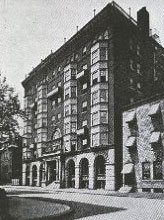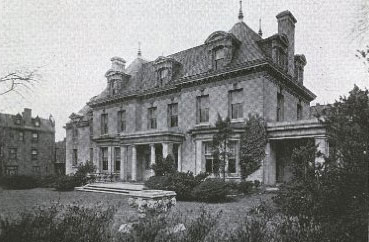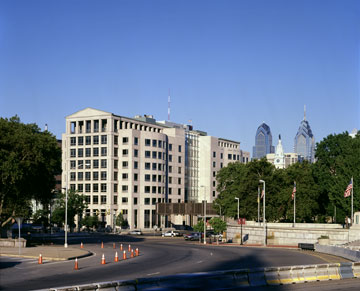Founding in New York
The American College of Physicians (ACP) was founded in 1915 and headquartered in New York City. ACP’s Founder, Dr. Heinrich Stern, and all of the College’s officers lived in either New York City or its surrounding suburbs. After Dr. Stern’s death on December 30, 1918, the College had a brief period of turmoil and disagreement over leadership and the institution’s future. This was concluded with what could be described as a "benign coup d’état" by Drs. Frank Smithies of Chicago, Clement Jones of Pittsburgh, and William Gerry Morgan of Washington, D.C. As a result, all current officers of the College resigned and the administrative framework of College was nearly completely restructured by a new leadership. One of the first changes implemented by the new regime was to move the College’s headquarters to Chicago, as it was believed that establishing a location near the center of the United States would enable the College to be more likely viewed as a national institution. It is also likely not coincidental that the College’s new Secretary-General, Frank Smithies, who at that time was the principal leader in the organization, practiced in Chicago.
Leadership of Frank Smithies
Under Frank Smithies’ leadership, the College prospered, with its membership increasing and a revived sense of enthusiasm among the leadership. From the beginning of Dr. Smithies’ tenure in 1918, he gradually exercised greater authority, and by 1925 he completely dominated the College’s policies. This brought him into conflict with Dr. Alfred Stengel of Philadelphia, who had assumed the Presidency of the College that year. While Dr. Stengel and many members of the Board of Regents (BOR) appreciated Dr. Smithies’ contributions to the College, they were increasingly concerned about his dictatorial style over all aspects of College life. During the College’s 10th Annual Session in Detroit and Ann Arbor, Michigan, on February 27, 1926, Dr. Stengel and a majority of the BOR attempted to fire Dr. Smithies. This potential change was met with great resistance from Regents loyal to Dr. Frank Smithies, and as a result, no action was taken.
Shortly thereafter, a self-appointed group composed of the President and Drs. Charles F. Martin, William Gerry Morgan, and Charles Jennings drew up a plan that they hoped would remove Dr. Smithies from power without embarrassing him further or damaging the College’s reputation. The plan called for Dr. Smithies to be elevated to President-Elect, becoming Dr. Stengel’s successor by 1927. The Secretary-Generalship would then be vacated and replaced with a paid non-medical administrator to be known as the Executive Secretary. This would, therefore, transfer the management of the College from a medical to a non-medical administrator who would be viewed as free of factional affiliations. It was further agreed that the administrative headquarters of the College, including all its files and records, should be moved from Chicago to the Eastern Seaboard, preferably Philadelphia. (Dr. Stengel taught at the University of Pennsylvania.) These suggestions were agreed to by Dr. Smithies and approved by the Board of Regents.
Move to Philadelphia
With the hiring of Edward R. Loveland as Executive Secretary of ACP, the headquarters was officially moved to Philadelphia in 1926. In order to provide a Philadelphia headquarters and an office for the Executive Secretary, quarters were rented in the Covington Hotel at 37th and Chestnut Streets, Philadelphia, which was situated near Dr. Stengel's office at the University of Pennsylvania. By 1928 the Covington Hotel was no longer considered an appropriate location for the College, and a newer and more modern headquarters was needed. Accordingly, the College leased a new headquarters from the Integrity Trust Building at 36th and Walnut Streets. Prior to 1935 it had became obvious to many that the College required a permanent headquarters. A special committee was authorized to begin searching for properties to be purchased. As a result, the College would actually own its next headquarters.

In 1935 a committee was appointed to investigate the available options for acquiring a permanent home for the College in Philadelphia. Dr. Alfred Stengel chaired this committee, which after a thorough review of several options, recommended to the Board of Regents the purchase of a house at 4200 Pine Street, the Eisenlohr Mansion, as the College’s new headquarters. The French Renaissance-style mansion was designed by Philadelphia architect Horace Trumbauer in 1904 for the Charles Eisenlohr family, owners of the Conco Cigar Company. The initial decorations and furnishings of the mansion were provided by O. H. Perry Pepper. Dr. Pepper and Dr. Stroud, as members of the house committee, were largely responsible for the decorations and furnishings of the house.
Permanent Philadelphia Home
The permanent home was occupied in the autumn of 1936 at a cost of $64,000.00, including the necessary alterations, repairs and furnishings. The annual maintenance and residential taxes for this home was approximately $5,600.00. This was about $3,000.00 a year more than the maintenance costs at the College’s previous headquarters. The previous owner of the property, C. J. Eisenlohr, gave the College as a gift several items that were part of his home, including andirons, draperies and a billiards table. This purchase gave the American College of Physicians a permanent setting that was unique, attractive and well suited to a growing organization.

As the years went on, the College did grow both in scope and staff size. By 1959, the Eisenlohr Mansion’s space had become insufficient to serve the College’s needs. The Board of Regents recommended that the College’s House Committee make an immediate survey of the need for expansion of the College’s headquarters building in Philadelphia, and report back to the BOR as of November 1959. At its November 15 meeting, the BOR approved architectural drawings and plans and set aside a fund of $100,000 for the project and approved a total cost of up to $350,000. Bids on the project were far in excess of the initial estimate. The lowest bid, which included the architect's fees, construction costs, grading and landscaping, exceeded $425,000. Consequently, the House Committee instructed the architect to revise the plans and specifications to come more within the budget of the College.
In October 1960, a new bid from the R. M. Shoemaker Company amounted to a reduction of about $46,000 from their previous bid. The central revisions were the installation of less expensive heating and air conditioning units, the substitution of wood floors for concrete, and a modification of the landscaping of the parking lot and driveway. The BOR gave final approval for the revised plans at their November 1960 meeting. A supplemental budget appropriation was needed to add furnishings to the new wing and renovate the original structure. The Eisenlohr Mansion was rewired, painted and plastered where necessary; while a new kitchen/dining room was created on the ground floor and the heating system was modernized. The new wing at the College’s Headquarters was ready for use on October 1, 1961.
Destruction by Fire
One of the decisions made in 1961 to make the construction of the Eisenlohr Mansion’s new wing (located at 4200 Pine Street) affordable was the substitution of wood floors for concrete. This practical decision would later be reexamined due to a fire that destroyed a considerable portion of the headquarters’ new wing on February 17, 1966. It was concluded that a defective electric motor in one of the new air conditioning units caused the fire. The College was quite lucky despite the level of damage done to the headquarters. All membership records, proposals for new membership, postgraduate course registrations and all pre-registration for the 1966 New York Annual Session were intact. Only two Annals manuscripts, lying on a desk while being edited, were destroyed; the rest were in a steel filing cabinet and were only scorched around the edges. While all advertising records were destroyed, the Addressograph plates in the Circulation Department remained relatively untouched. Consequently, the April 1966 issue of Annals of Internal Medicine was mailed to subscribers only a few days late.
Objects and memorabilia, which are currently on display in ACP’s Boardroom area, also managed to survive this fire intact. The oil painting of Mr. Edward R. Loveland, the former Executive Secretary of the College, that hung in the Boardroom was completely covered with soot, but fortunately was restored to virtually perfect condition. The College Mace, used for the first time the previous year at the 50th Anniversary celebration in Chicago, as well as the Caduceus and the President's Badge, were also undamaged. A pre-Civil War farm house adjacent to the headquarters structure, which the College also owned, was occupied by the Group Insurance Administrators (GIA). With the cooperation of the GIA, most of the College Administrative Staff, along with the Editorial Department of the Annals, were crowded into the building until the damaged wing could be rebuilt. The College Staff also was able to use the basement of an undamaged part of the headquarters building to operate at near normal capacity during the rebuilding. The R. M. Shoemaker Co., which had erected the burned out wing five years earlier, estimated that it would cost approximately $325,000 to rebuild.
Reconstruction began in June 1966, and it was hoped that reoccupancy could take place by early 1967. Eleven months after the fire destroyed the west wing, the Administrative Staff of the American College of Physicians moved into the reconstructed building. The College received $341,079 as part of the insurance settlement for the fire damage. The Board of Regents also agreed to several improvements not covered by insurance, which totaled approximately $66,000. These included additional offices as well as new fire protection and air conditioning systems. In 1970, new additions were added to the headquarters and were completed fully by 1972. The College now had a five-story wing including an adjacent parking area and driveway. The total cost of the building additions was $1,318,494. This was financed through a special assessment of the members, which raised $544,370, and by the previously cumulated building fund, accrued annually at $100,000.
Move to Independence Mall
In 1984, Executive Vice-President Dr. Robert H. Moser and other ACP leaders decided that the College would benefit a great deal from moving into a new headquarters. The building at 4200 Pine Street, which had served as the College’s headquarters for nearly fifty years, was no longer suited as the center of operations for the nation’s largest specialty medical society. Leadership began to explore the financial feasibility of building and sustaining a new headquarters. After a period of exploration, College leadership concluded that the College could afford to build a new headquarters and the search for a new site commenced.

A site selection committee was formed and several options were examined, including the possibility of relocating the College to Baltimore or Washington D.C. Among the many considerations contributing to the decision to remain in Philadelphia was the desire to retain the College’s local staff of about 200, whose roots were in the Philadelphia region. Philadelphia had also served as the College’s home for 60 years and it was thought that a move to Washington, D.C. might be misconstrued as a departure from ACP’s educational mission in favor of health policy activities.
In April 1986 the site selection committee, under the leadership of the President-elect, Dr. Ceylon S. Lewis, eventually recommended the purchase of a building site on the west side of Philadelphia's celebrated Independence Mall. The site area was between Sixth and Seventh Streets bordering on Race Street and was the location of the former Bicentennial Exhibit which was constructed in the early 1970s by the city for the nation’s Bicentennial. The College began negotiations with the city's Philadelphia Redevelopment Corporation, and various officials in Mayor Wilson Goode’s administration. The city was only able to sell the College the area on Sixth Street bordering on Race Street, since WHYY-TV had a long-term lease on a section of the Seventh Street side. Ultimately a compromise was reached as the College agreed to accept about three quarters of the initial location.
The Independence Mall site was ultimately approved and, although the College maintained a satellite office in Washington for purposes of congressional liaison, all other activities would remain under one roof in Philadelphia. Construction on the new building began in 1987 and was completed for occupancy by 1989. By the late 1990s, WHYY-TV had moved to a new location next door to the College. After further renovation on their new building gave them additional space, WHYY-TV no longer needed to retain their lease with the city for the location on Seventh Street. Consequently the College was able to acquire the remaining section from the City of Philadelphia in 2000. Construction begun within months of the purchase of the west wing, which was fully occupied as of April of 2002.
Sources:
- Prepared by Eric Greenberg, based on materials from the Archives of the American College of Physicians
- Morgan, William G. The American College of Physicians: Its First Quarter Century. Philadelphia, 1940
- Piersol, George M. Gateway of Honor: The American College of Physicians, 1915-1959. Lancaster, PA: Lancaster Press, 1962
- Rosenow EC Jr. History of the American College of Physicians: Executive Perspectives, 1959-1977. Philadelphia: American College of Physicians, 1984
- Moser, Robert H. A Decade of Decision: A Physician Remembers the American College of Physicians 1977-1986. Philadelphia, PA: American College of Physicians, 1991.

